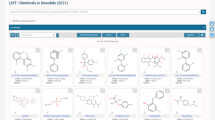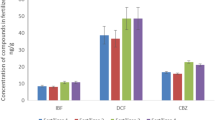Abstract
Disposal of sewage sludge by application to agricultural and other land is widely practised and is presumed to be environmentally beneficial, but we have found high concentrations of an environmentally persistent class of organic pollutants, brominated diphenyl ethers (BDEs), in 'biosolids' from four different regions of the United States. These compounds are widely used as flame retardants, and their presence suggests that the environmental consequences of land application of biosolids need further investigation. We also frequently detected BDEs in wild-caught fish, indicating another pathway for human exposure.
This is a preview of subscription content, access via your institution
Access options
Subscribe to this journal
Receive 51 print issues and online access
$199.00 per year
only $3.90 per issue
Buy this article
- Purchase on Springer Link
- Instant access to full article PDF
Prices may be subject to local taxes which are calculated during checkout

Similar content being viewed by others
References
US Environmental Protection Agency. Biosolids Generation, Use and Disposal in the United States. EPA530-R-99-009 (Washington DC, 1999).
National Academy of Sciences. Use of Reclaimed Water and Sludge in Food Crop Production (Washington DC, 1996).
Di Carlo, F. J. et al. Environ. Health Perspect. 23, 351–365 (1978).
Renner, R. Environ. Sci. Technol. 34, 452A–453A (2000).
World Health Organization. Environmental Health Criteria 162: Brominated Diphenyl Ethers (Geneva, 1994).
de Boer, J., Wester, P. G., Klamer, H. J. C., Lewis, W. E. & Boon, J. P. Nature 394, 28–29 (1998).
Renner, R. Environ. Sci. Technol. 34, 223A–226A (2000).
Sellstrom, U. et al. Organohalogen Compounds 40, 383–386 (1999).
European Commission press release, 30 January 2001.
Strandberg, B. et al. Environ. Sci. Technol. 35, 1078–1083 (2001).
Author information
Authors and Affiliations
Corresponding author
Supplementary information
Rights and permissions
About this article
Cite this article
Hale, R., La Guardia, M., Harvey, E. et al. Persistent pollutants in land-applied sludges. Nature 412, 140–141 (2001). https://doi.org/10.1038/35084130
Issue Date:
DOI: https://doi.org/10.1038/35084130
This article is cited by
-
The United Nations General Assembly Passes Historic Resolution to Beat Plastic Pollution
Anthropocene Science (2022)
-
Understanding the mechanism of polybrominated diphenyl ethers reducing the anaerobic co-digestion efficiency of excess sludge and kitchen waste
Environmental Science and Pollution Research (2022)
-
The Influence of Substitution of a Phosphorus-Containing Polyol with the Bio-polyol on the Properties of Bio-based PUR/PIR Foams
Journal of Polymers and the Environment (2018)
-
Polybrominated diphenyl ethers (PBDEs) in core sediments from creek ecosystem: occurrence, geochronology, and source contribution
Environmental Geochemistry and Health (2018)
-
The synthesis of melamine-based polyether polyol and its effects on the flame retardancy and physical–mechanical property of rigid polyurethane foam
Journal of Materials Science (2017)
Comments
By submitting a comment you agree to abide by our Terms and Community Guidelines. If you find something abusive or that does not comply with our terms or guidelines please flag it as inappropriate.



